Abstract
Pyrimidine nucleotides, detectable in normal erythrocytes only in trace quantities if at all, were found to comprise 7-80% of the intracellular nucleotide pools in nine subjects with severe lead over-burden. Blood lead concentrations ranged from approximately equal to 200- to 400-microgram/dl packed cells, and the greatest accumulations of pyrimidine-containing nucleotides occurred in the two subjects with the highest blood lead levels. Most of the patients had mild or moderate anemia and moderate basophilic stippling evident in Wright's-stained peripheral smears. Pyrimidine nucleotidase activities were inhibited to 13-28% of the mean activity in normal control erythrocytes and even more so (5-15%) when compared to specimens with increased reticulocytes and young cells. Reticulocytosis was absent in two subjects and modest to moderate in the remainder, but erythrocyte assays revealed the substantial elevations in populations of young mean cell age. Inappropriately low reticulocyttial elevations in glucose-6-phosphate dehydrogenase expected in populations of young mean cell age. Inappropriately low reticulocyte responses may reflect hematopoietic suppressive effects of lead at a variety of metabolic loci.
Full text
PDF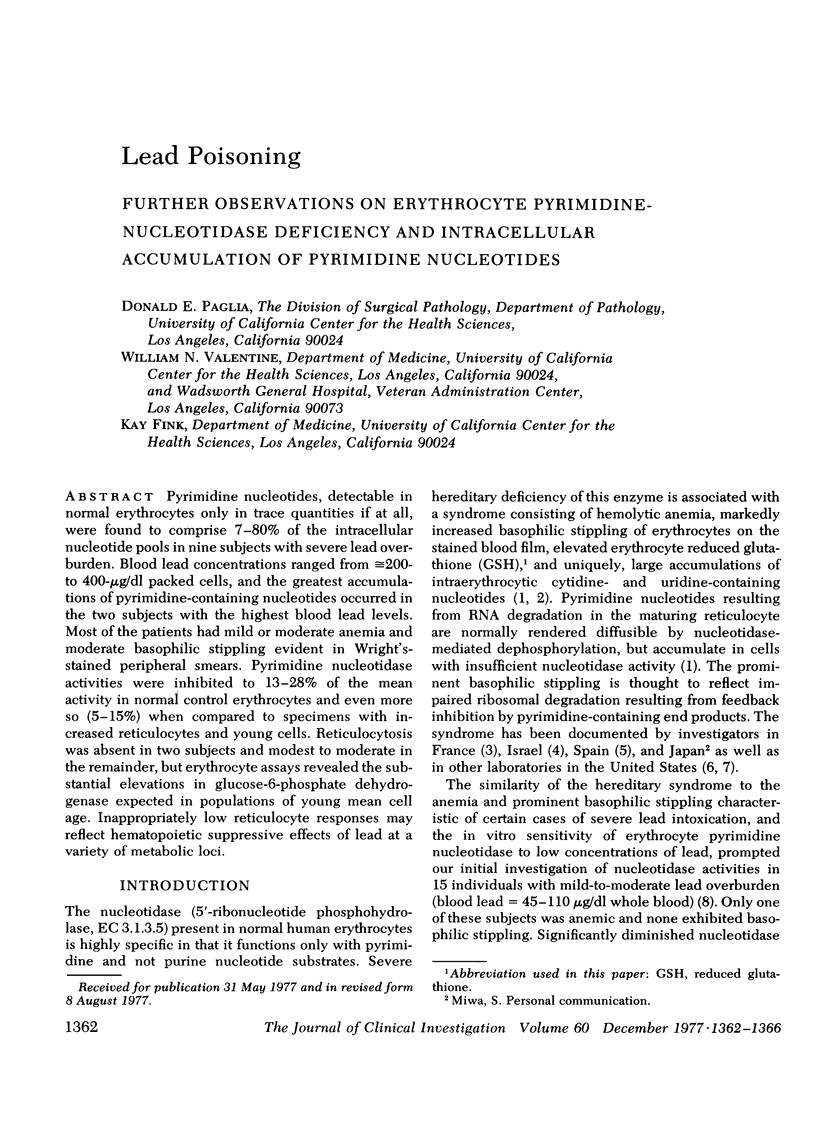
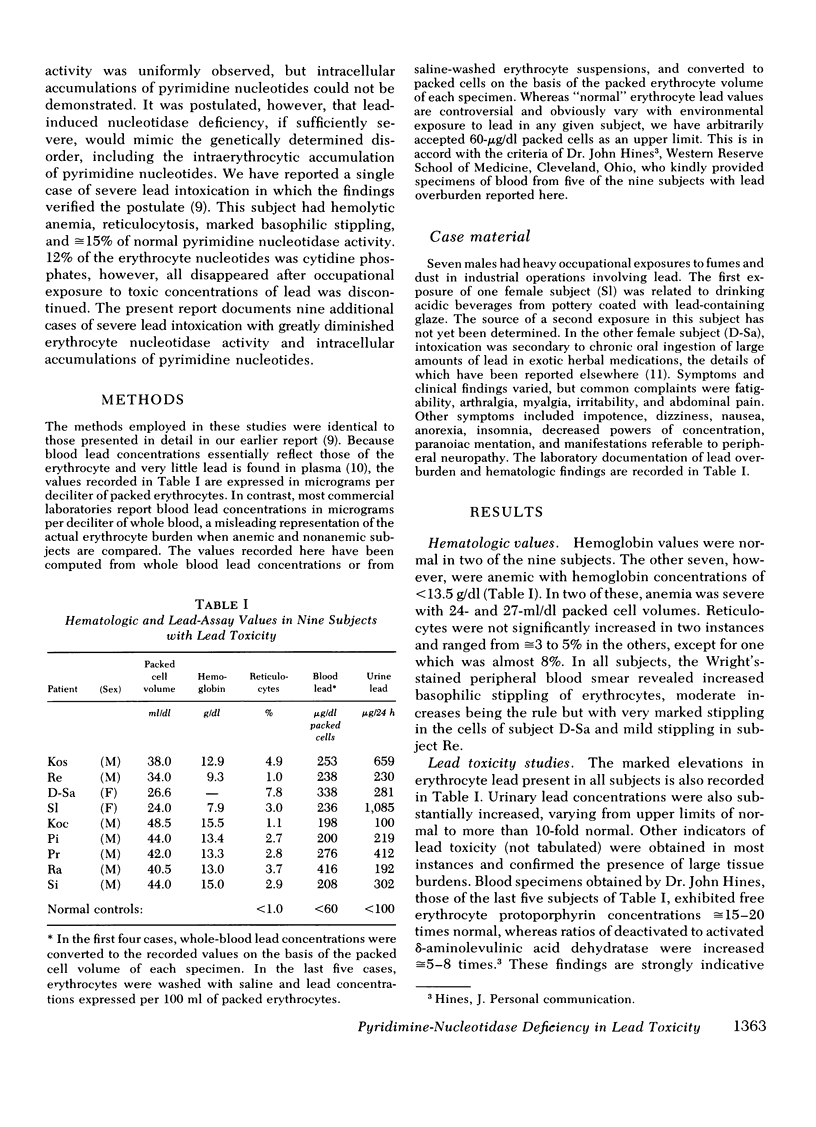
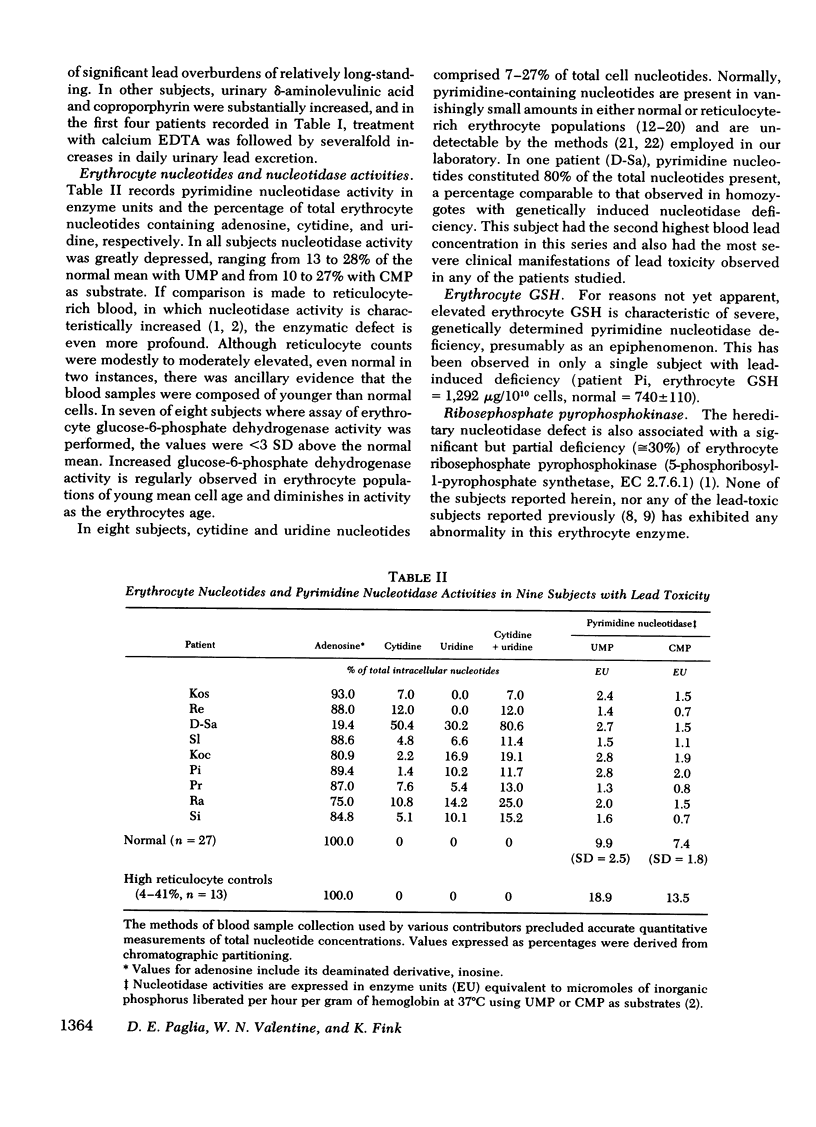
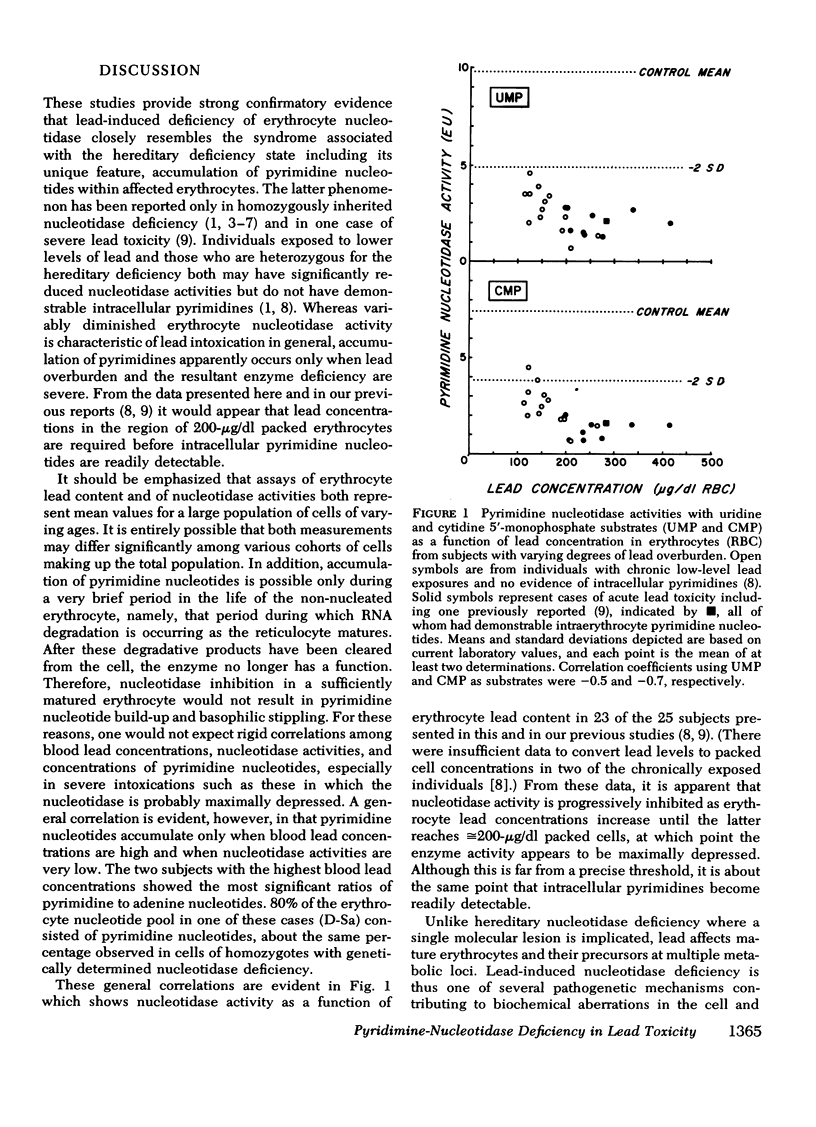
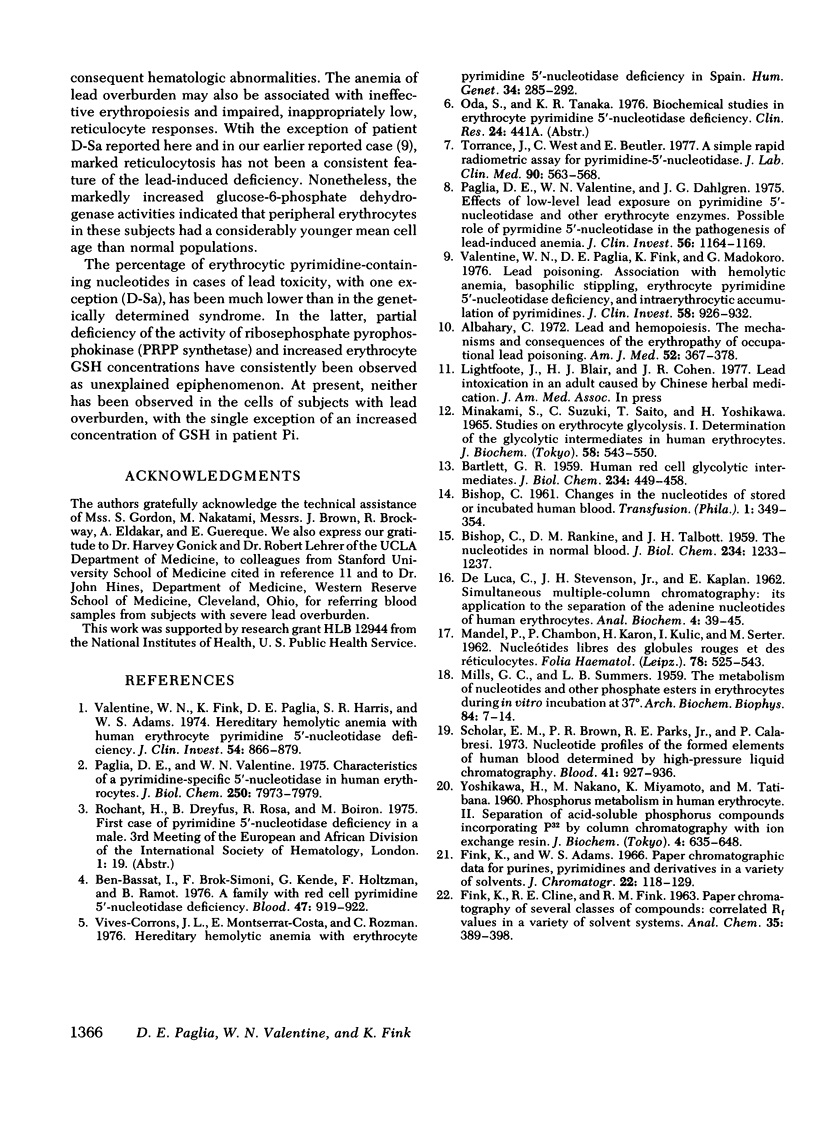
Selected References
These references are in PubMed. This may not be the complete list of references from this article.
- Albahary C. Lead and hemopoiesis. The mechanism and consequences of the erythropathy of occupational lead poisoning. Am J Med. 1972 Mar;52(3):367–378. doi: 10.1016/0002-9343(72)90025-3. [DOI] [PubMed] [Google Scholar]
- BARTLETT G. R. Human red cell glycolytic intermediates. J Biol Chem. 1959 Mar;234(3):449–458. [PubMed] [Google Scholar]
- BISHOP C. Changes in the nucleotides of stored or incubated human blood. Transfusion. 1961 Nov-Dec;1:349–354. doi: 10.1111/j.1537-2995.1961.tb00073.x. [DOI] [PubMed] [Google Scholar]
- BISHOP C., RANKINE D. M., TALBOTT J. H. The nucleotides in normal human blood. J Biol Chem. 1959 May;234(5):1233–1237. [PubMed] [Google Scholar]
- Ben-Bassat I., Brok-Simoni F., Kende G., Holtzmann F., Ramot B. A family with red cell pyrimidine 5'-nucleotidase deficiency. Blood. 1976 Jun;47(6):919–922. [PubMed] [Google Scholar]
- DE LUCA C., STEVENSON J. H., Jr, KAPLAN E. Simultaneous multiple-column chromatography: its application to the separation of the adenine nucleotides of human erythrocytes. Anal Biochem. 1962 Jul;4:39–45. doi: 10.1016/0003-2697(62)90017-9. [DOI] [PubMed] [Google Scholar]
- Fink K., Adams W. S. Paper chromatographic data for purines, pyrimidines and derivatives in a variety of solvents. J Chromatogr. 1966 Apr;22(1):118–129. doi: 10.1016/s0021-9673(01)97077-3. [DOI] [PubMed] [Google Scholar]
- MILLS G. C., SUMMERS L. B. The metabolism of nucleotides and other phosphate esters in erythrocytes during in vitro incubation at 37 degrees. Arch Biochem Biophys. 1959 Sep;84:7–14. doi: 10.1016/0003-9861(59)90548-x. [DOI] [PubMed] [Google Scholar]
- Minakami S., Suzuki C., Saito T., Yoshikawa H. Studies on erythrocyte glycolysis. I. Determination of the glycolytic intermediates in human erythrocytes. J Biochem. 1965 Dec;58(6):543–550. doi: 10.1093/oxfordjournals.jbchem.a128240. [DOI] [PubMed] [Google Scholar]
- Paglia D. E., Valentine W. N. Characteristics of a pyrimidine-specific 5'-nucleotidase in human erythrocytes. J Biol Chem. 1975 Oct 25;250(20):7973–7979. [PubMed] [Google Scholar]
- Paglia D. E., Valentine W. N., Dahlgren J. G. Effects of low-level lead exposure on pyrimidine 5'-nucleotidase and other erythrocyte enzymes. Possible role of pyrimidine 5'-nucleotidase in the pathogenesis of lead-induced anemia. J Clin Invest. 1975 Nov;56(5):1164–1169. doi: 10.1172/JCI108192. [DOI] [PMC free article] [PubMed] [Google Scholar]
- Scholar E. M., Brown P. R., Parks R. E., Jr, Calabresi P. Nucleotide profiles of the formed elements of human blood determined by high-pressure liquid chromatography. Blood. 1973 Jun;41(6):927–936. [PubMed] [Google Scholar]
- Torrance J., West C., Beutler E. A simple rapid radiometric assay for pyrimidine-5'-nucleotidase. J Lab Clin Med. 1977 Sep;90(3):563–568. [PubMed] [Google Scholar]
- Valentine W. N., Fink K., Paglia D. E., Harris S. R., Adams W. S. Hereditary hemolytic anemia with human erythrocyte pyrimidine 5'-nucleotidase deficiency. J Clin Invest. 1974 Oct;54(4):866–879. doi: 10.1172/JCI107826. [DOI] [PMC free article] [PubMed] [Google Scholar]
- Valentine W. N., Paglia D. E., Fink K., Madokoro G. Lead poisoning: association with hemolytic anemia, basophilic stippling, erythrocyte pyrimidine 5'-nucleotidase deficiency, and intraerythrocytic accumulation of pyrimidines. J Clin Invest. 1976 Oct;58(4):926–932. doi: 10.1172/JCI108545. [DOI] [PMC free article] [PubMed] [Google Scholar]
- Vives-Corrons J. L., Montserrat-Costa E., Rozman C. Hereditary hemolytic anemia with erythrocyte pyrimidine 5'-nucleotidase deficiency in Spain. Clinical, biological and familial studies. Hum Genet. 1976 Dec 15;34(3):285–292. doi: 10.1007/BF00295292. [DOI] [PubMed] [Google Scholar]


